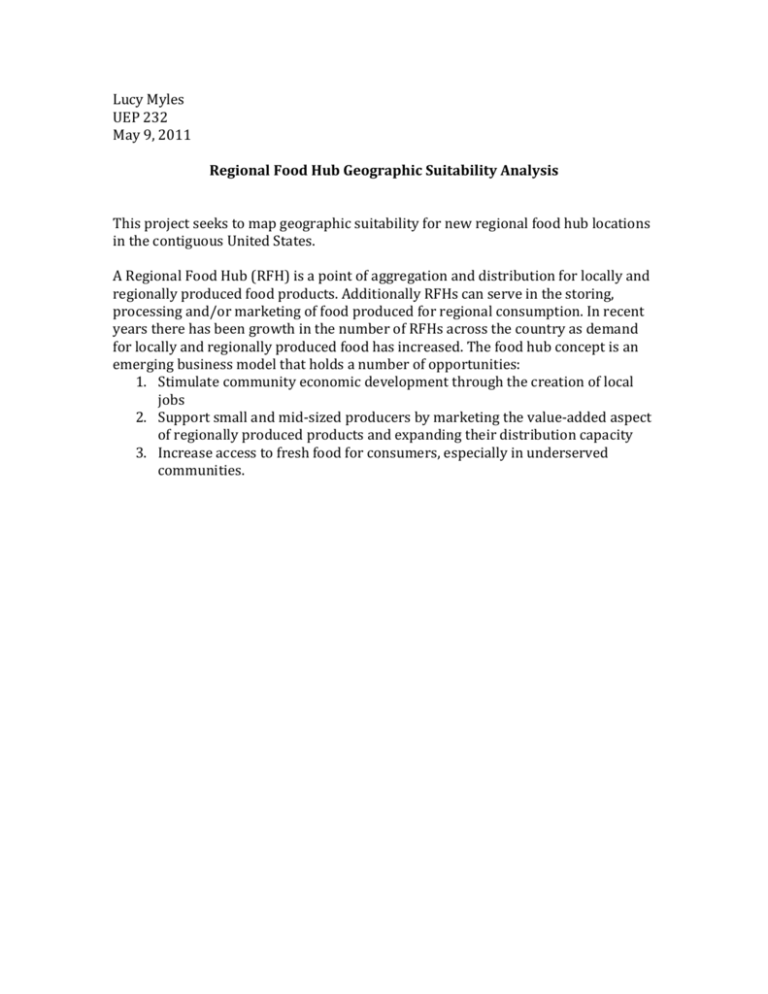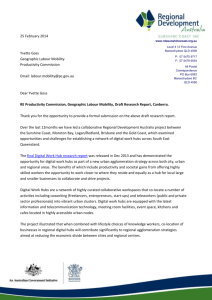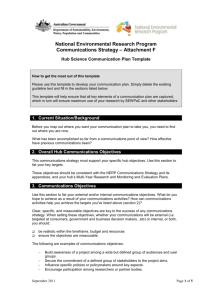Myles_final paper
advertisement

Lucy Myles UEP 232 May 9, 2011 Regional Food Hub Geographic Suitability Analysis This project seeks to map geographic suitability for new regional food hub locations in the contiguous United States. A Regional Food Hub (RFH) is a point of aggregation and distribution for locally and regionally produced food products. Additionally RFHs can serve in the storing, processing and/or marketing of food produced for regional consumption. In recent years there has been growth in the number of RFHs across the country as demand for locally and regionally produced food has increased. The food hub concept is an emerging business model that holds a number of opportunities: 1. Stimulate community economic development through the creation of local jobs 2. Support small and mid-sized producers by marketing the value-added aspect of regionally produced products and expanding their distribution capacity 3. Increase access to fresh food for consumers, especially in underserved communities. Table 1 Data source US Population Census Metadata Food Hub Collaborative: Agricultural Marketing Service StreetMap USA Metadata US Economic Census Data query tool and variable descritptions Year 2000 Variables County polygons 2011 Existing Food Hub zip codes 2002 National highway system 2007 Commercial fishing Small farms with < $250,000 in annual sales Refrigerated warehouse and storage Farm product warehouse and storage (nonrefrigerated) Local freight trucking F&V freezing F&V canning, drying, pickling Animal slaughter and processing Seafood prep and packaging Colleges, universities, and professional schools Elementary and secondary schools Hospitals # of grocery stores in 2008 Percent organic of total farmland Percent organic of total producers % farms using conservation methods Number of farms with direct sales % Farms with direct sales % Farm sales $ direct to consumer # of farmers markets Number of farm to school program US Agricultural Census Data query tool Metadata 2007 USDA Agricultural 2010 Marketing Service Farmers’ Market Directory National Farm to 2010 School Network. Data accessed through the Food Environment Atlas Data and variable descriptions Variables were included in the analysis based on six key suitability concepts: Regional food production, transportation and storage infrastructure, food processing infrastructure, environmental services, demand for regional food, and potential markets for regional food. The table 2 shows each concept with the input variable. Table 2 Concept Variables Commercial fishing Food production Small farms with < $100,000 in annual sales Miles of highway Refrigerated warehouse and storage Regional transportation and storage infrastructure Farm product warehouse and storage and services (non-refrigerated) Local freight trucking establishments Frozen fruit and vegetable manufacturing Fruit and vegetable canning, drying, Regional food processing infrastructure and services and pickling facilities Animal slaughter and processing Seafood processing Percent organic of total farmland Value-added: Number of organic operations environmental services Percent organic of total producers Demand for local/regional food using direct marketing as proxy measure Potential markets for food hubs Number of farm to school program Number of farms with direct sales % Farms with direct sales % Farm sales $ direct to consumer # of farmers markets in 2010 Colleges, universities, and professional schools Elementary and secondary schools Hospitals # of grocery stores in 2008 RFH counties mean values 5.27 168.22 422.76 2.73 0.57 67.80 0.47 2.41 6.76 1.76 0.70 14.82 1.22 0.35 125.92 11.56 2.44 10.78 10.69 50.61 9.00 140.80 Existing food hub counties were identified based on the USDA Agricultural Marketing Service working Food Hub Database. The mean value for each input variable was calculated for all counties with existing food hubs (see table 2). This value was used as a threshold point to identify food hub suitability for each input variable. A ranking scheme was developed for each concept to assign a suitability score for each counties based on the number of input variables that met the determined suitability level. Finally, a composite map was created to represent all six suitability concepts. 23 Data variables 6 Concept maps Final suitability map List of major steps in data preparation and analysis: 1. Download data from data sources (see table 1 for data sources and appendix for steps on downloading data) 2. Prepare data in excel for GIS import with matching FIPS code (see appendix for steps on creating 5 digit FIPS in excel) 3. Import excel spreadsheets into ArcGIS and perform table join with 2000 census county shape file using FIPS as join point 4. Project all data layers to the same coordinate system (US Contiguous Albers Equal Area Conic 1983) 5. Geocode existing food hubs using 2000 census county zip code shape file 6. Geocode farmers market locations from the AMS Farmers Market Database using 2002 StreetMap USA 7. Perform a special join with the county data and the farmers market point locations for a count of farmers markets by county 8. Create a new column to identify counties as food hub or no food hub. Select by attribute for counties containing a food hub zip code. Add a code for food hubs to the selected counties. Invert the selection and add a code for no food hub for the new selection 9. View the mean value for each of the data variables included in this analysis within food hub counties 10. Create a second column for each of the data variables included in this analysis. For each variable select by attribute all counties above the mean value for food hub counties. Assign a 1 in the new column for each county that meets the threshold for each variable 11. Create new columns for each of the 6 concepts. Add the values for the variables that contribute to the concept. 12. Create maps for each of the concept variables using quantiles to visualize the sum of the input variables for each county. 13. Create a new column for the composite analysis. Add the values for all input variables. 14. Create a composite map using quantiles to visualize the sum of all input variables used in this analysis Difficulties: The major challenge with this project was managing large amounts of data from a number of sources and successfully merging all data into a single table. I ended up with many versions as I joined new data tables and had to save each new resulting data layer. Successful data management required a high degree of organization and planning to make sure that I was working with the most updated data set. A second challenge was figuring out how to make composite scores of data input variables for the different concept maps and for the final map representing all data inputs. I depended heavily on the ability to make new data columns and selecting by attribute to make each variable binomial (meets threshold/does not meet threshold). Again, this required a lot of attention and data management. Observations: Based on the variables and threshold values used in this analysis it is clear that the regions in the U.S. with the highest food hub suitability are the Northeast and the West Coast. A number of existing food hubs are located in areas that are designated as highly suitable based on this analysis. However, the largest cluster of existing food hubs is in the Upper Midwest, which was not ranked as highly based on the suitability criteria used for this analysis. Limitations and areas for future investigation: The threshold criteria for each variable should be explored further to take account of the range of deviation from the mean value among existing food hub counties and to test whether the threshold values are significantly different from the mean value of all U.S. counties. Further it would be interesting to represent more than just the determined threshold point for each input variable. This could be done by creating quantiles within each variable and assigning values for the concept based on the variable quantile range. Some of the variables specifically reflect structures that are relevant to local and regional food systems, such as measuring demand for regional food using direct marketing activity as a proxy measure. However, other variables that were used are not specific to regional food system. For instance the food processing infrastructure variables includes facilities that are at a larger scale than producers and distributors of regional food can access. Looking specifically at small-scale food processing infrastructure would be more relevant to regional food system mapping, however these data are not publically available disaggregated to facility size. There is also room for continued exploration with other concept areas. For example supporting disadvantaged producers, and increasing food access in underserved communities are two concepts that many food hubs strive to incorporate in their models. However, input data for these concepts were not included in this analysis. Finally, it is important to realize that the variables included in this analysis are only a few of the many components that contribute to a vibrant regional food system. A tool such as this could be used to identify potential new food hub counties based on existing factors However, the most important work in determining food hub suitability is done on the ground through relationship building in the community. Annotated references: The Regional Food Hub Advisory Council has already done some suitability mapping for California, which is presented in the document “California Network of Regional Food Hubs”. Through this analysis potential new food hub sites are suggested using supply and demand indicators. However, the indicators that are used are not sufficiently sensitive measures.1 The Vermont Sustainable Agriculture Council released a document in 2008 titled “Mapping Vermont’s Local Food System.” In this document a number of maps are presented, which use much more refined indicators for both the supply and demand of locally produced food.2 Gibbs and Bernat examine the benefits of industry clusters on rural economies in the paper titled “Rural Industry Clusters Raise Local Earnings”. These researchers use an interesting methodology for identifying industry clusters, which is a Moran statistic. The Moran statistic measures the value of a given variable for neighboring counties to the county of interest. This could be a useful methodology to use for future RFH suitability analysis because it would allow for the analysis to consider regional designations beyond the county level, yet would not be constrained by state boundaries.3 In the article “Mapping potential foodsheds in New York State” Peters et al map food production potential as a way to examine the ability for New York State to feed itself. This level of analysis will be too detailed for the purpose of the RFH suitability analysis, however, it could be a useful methodology for future analysis.4 Citations: 1. The Regional Food Hub Advisory Council. California Network of Regional Food Hubs: A vision statement and strategic implementation plan. September 2010 2. Erickson, Dan. Mapping Vermont’s Local Food System. The Vermont Sustainable Agriculture Council. October 2008 3. Gibbs, R and Bernat, A. Rural Industry Clusters Raise Local Earnings. Rural Development Perspectives. Vol. 12. No 3. 4. Peters, C et al. Mapping potential foodsheds in New York State: A spatial model for evaluating the capacity to localize food production. Renewable Agriculture and Food Systems. 24(1). 72-84. October 2008. Appendix: Downloading and preparing tabular data: Downloading data from NASS Quick Stats: Start here: http://quickstats.nass.usda.gov/ 1. Select: commodity Geographic location Time (the page will update to provide choices after each selection) 2. Select the “get data” button once everything has been selected 3. View the table to make sure it’s the data you want and then select “spreadsheet” from the options in the upper right to download in excel format. 4. Note: Ag census data is only available through the Quick Stats tool from 1997 onwards. For older data you have to look up the tables: http://www.agcensus.usda.gov/ Downloading data from the Food Environment Atlas: Start here: http://www.ers.usda.gov/foodatlas/ 1. Select download data in the upper right tab 2. Select the download button on this page for all of the Food Environment Atlas data in a single spreadsheet ready for import into ArcGIS Downloading Economic Census data from American Factfinder: Start here: http://www.census.gov/cgibin/sssd/naics/naicsrch?chart_code=61&search=2007%20NAICS%20Search 1. Find desired NAICS code(s) Then go here: http://factfinder.census.gov/servlet/IBQTable?_bm=y&ds_name=CB0700A1 1. From the menu bar at the top, Filter Filter Rows. 2. On the first line, type in the 6-digit NCAIS code, and hit Search. 3. The Code and the Industry will appear in the box just below. Highlight that line and hit Add. 4. After the same Code and Industry appear in box below Add, highlight that entry and hit Show Results. 5. Under Options, choose “Select Columns” and check off the box marked Geographic Identifier Code (this is the combined 5-digit FIPS) 6. Click on Update (if you don’t want the number of employees etc, you can de-select those options under that same check-box place) 7. Under Print/Download on toolbar, select Download. 8. In the popup window, select OK. Creating 5 digit FIPS in excel for successful GIS table joins 1. Most of the geographic identifyers provide the state FIPS and the county FIPS in separate columns. However, for the purpose of joining it is necessary to have them together as a single 5 digit code (2 digit state code and 3 digit county code) 2. Put the state FIPS codes in column A and the county FIPS codes in column B. 3. In column C paste this code: =TEXT(A2,"00")&TEXT(B2,"000") 4. Copy all of column C and select “past special”. Select the “value” option. This will transfer the FIPS column from a formula to number.





